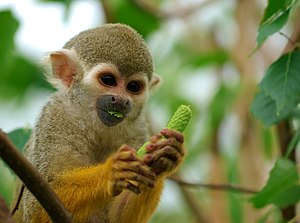Euarchonta
| Euarchonta | ||||||||||||
|---|---|---|---|---|---|---|---|---|---|---|---|---|

Common squirrel monkey ( Saimiri sciureus ) |
||||||||||||
| Systematics | ||||||||||||
|
||||||||||||
| Scientific name | ||||||||||||
| Euarchonta | ||||||||||||
| Waddell , Okada & Hasegawa , 1999 | ||||||||||||
| Orders | ||||||||||||
|
As euarchonta ( gr. Ευ "good, genuine"; άρχοντ "ruler"; see. Archon ) is a clade called, in addition to the primates and the giant gliders (as primatomorpha summarized), the tree shrews includes. The Euarchonta were established in 1999 on the basis of genetic investigations by excluding the bats (Chiroptera) from the group of Archonta previously postulated on the basis of morphological criteria . The extinct order of the Plesiadapiformes is placed as a sister taxon of the primates to the Euarchonta.
The current data allow extrapolation based on the molecular clock that the Euarchonta were formed in the Cretaceous about 88 million years ago and split into the groups of shrews and primatomorpha 86.2 million years ago. The latter divided into the orders of primates and giant gliders 79.6 million years ago.
Systematics
The current (2007) scientific knowledge about the relationships is shown in this cladogram .
| Euarchontoglires |
|
||||||||||||||||||||||||||||||
|
|
swell
- Jan Ole Kriegs, Gennady Churakov, Jerzy Jurka, Jürgen Brosius and Jürgen Schmitz: Evolutionary history of 7SL RNA-derived SINEs in Supraprimates. In: Trends in Genetics . 23 (4). 2007, 158–161 ( online text as PDF ) (468 kB)